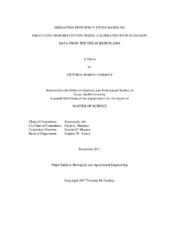| dc.description.abstract | The Texas High Plains form a unique region that has been a vital part of U.S. grain and fiber production for many decades. Areas in the Texas High Plains are experiencing the effects of conflicting interests in a diminishing water source, the Ogallala Aquifer. Proposals have been made to limit the quantity of water withdrawn from the aquifer for irrigation purposes, leading to increased interest in the adoption of efficient irrigation strategies. Decision Support System for Agrotechnology Transfer (DSSAT) is a modeling software that uses meteorological, soil, and field experimental data to predict crop growth, development, and yield, and it is very useful for evaluating the efficiency of crop and irrigation management strategies. This study details the calibration and verification of a DSSAT experiment based on an unpublished 2008 field study performed by the United States Department of Agriculture Agricultural Research Service (USDA-ARS) and the use of the calibrated model for determining best irrigation strategy in terms of crop yield and water use efficiency. The field study was conducted to compare the effects of different irrigation strategies on cotton yield. Due to the wealth of in-season data that was collected, these field data provided more opportunities for comparison between the experimental crop and the modelled crop than was available for past calibrations. Data from highly irrigated fields that experienced little water stress were used to calibrate the model, and the remaining deficit irrigation field data were used exclusively for verification of the calibrated model. The parameter values chosen in the final calibration were used in further irrigation simulation experiments. These were conducted over a testing range for four separate irrigation strategies to determine what minimum irrigation amount would yield the maximum yield and which strategy is the most efficient. The DSSAT CROPGRO-Cotton model demonstrated potential to simulate the effects of various irrigation strategies on cotton yield, and the 12mm, 7.5 hr Time Temperature Threshold strategy was found to be the strategy to achieve a maximized yield with the greatest water use efficiency. | en |


